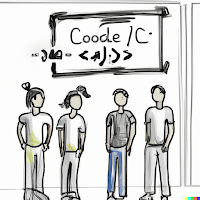 |
| Team in front of Computer Code, generated by DALL-E 2 |
What is the right size for a team? Can it be too big or too small? I worked with a team once that had 3 developers. They spent most their time mob programming in front of a 42 inch monitor, taking turns at the keyboard. They didn't need to do traditional stand-ups because they were swarming around one thing at a time. The Scrum Master kept an eye open for impediments, but otherwise was focused on the next thing that would improve the team's productivity.
I also worked with a team of 15. My first thought was that was too big, but as I watched the team work, I saw that wasn't the case. The team was doing data-science kind of work. They needed people who could write SQL to pull data from legacy systems and put it in data lakes and people who could take that data and package it in a report with Tableau. For this team, having all the skills on one team meant they didn't have dependencies with other teams.
An often cited paper by George Miller states the magic number at 7 +/- 2 people (sometimes referred to as Miller's Law). The 2-pizza rule says a team should be small enough to feed with 2 pizzas. Robin Dunbar's research suggests 15 is the upper limit of the number of people we can deeply trust.
There are other considerations beyond just the number of people. As I pointed out in my last post, dependencies slow teams down. My 15 person team was big, but still effective at delivering because they didn't have dependencies on other teams.
This larger team also had true cross-functional skills. My smaller team was effective because they were developing in a narrow field and didn't need a broad range of skills. However, if they found they were having dependencies on another team because of a missing skill, enlarging the team to include this skill could be a smart move.
In the book Team Topologies, Matthew Skelton and Manuel Pais talk about cognitive overload. Teams can only handle a limited number of different areas of focus. If the team is asked to do too many different types of work, the effectiveness of the team will suffer. Just like individuals can't multi-task effectively, neither can teams. So when deciding on the team composition, this should also be taken into account. My 15 person team was probably suffering from cognitive overload, but I wasn't looking for that at the time.
Too often I see teams put together without much thought. Worse yet is when people are partially allocated to more than one team. I think regardless of what framework or methodology you are using, you need to start off with deliberate thought about how to set up teams. I would recommend the book Team Topologies for guidance on this topic.
.jpeg)